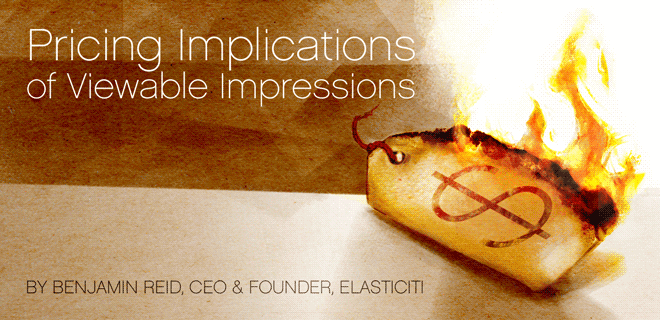
I’ve been asked by several publishers what I think about viewable impressions. While there has been lots of press extolling its virtues and equal amounts of questions and concerns about the implications, there hasn’t been a realistic discussion of how to manage the pricing of viewable impressions (VI).
A core selling point of VI is that it gives buyers confidence that they can eliminate up to 50% of the waste in a given campaign. As an industry founded on measurement, this is a logical extension and has the potential to be a good thing for all parties involved.
But we have a lot of work to do, especially on the sell side, to ensure that we are poised to profit from this emerging standard. I’ll leave the majority of the operational elements to others to discuss and will focus on the pricing dynamics.
Foundations
As a start, I would suggest gathering some critical data on this. This would of course mean studying the progress of the standard via the IAB site or others. As important, I would get data on your audience behavior. Site usage is very unique and I would not assume the averages around viewability and formats/placement are applicable to you. Contact ComScore or AdSafe Media about doing a limited test to get a benchmark for your analysis.
In parallel, I would connect with senior management to get their buy-in around doing the homework. You want to be sure you’re on the same page ASAP.
Lots of press/vendors/analysts have described this shift in overly simple terms – i.e., sellable impressions will drop by half and prices will double and everything will be hunky dory. The drivers of pricing any commodity are complex and scarcity is one variable of many. It’s important for publishers not to take a simplistic approach to repricing or have faith that the market will deliver premiums to their door.
Preparing to Win
In an Operative webinar, CEO Mike Leo (speaking at OPS) correctly stated that, “There will be winners and losers.” Winners will take advantage of this pricing opportunity to capture marketshare and premiums by developing a strategy that makes sense for the specifics of their site.
So how to re-price? ComScore has suggested that above-the-fold and below-the-fold ad units should have the same price if VI targeted. I think that misses out on a number of factors that are drivers of true value such as:
- Position – Higher is probably more premium in both the viewer’s and advertiser’s eyes. This is clearly evident in print where early in the book and top of page are more valuable.
- Size – Larger and more proportional usually perform better.
- Viewability – The less often a format meets the VI standard, the less premium inventory you have to sell. It’s not scarcity, it’s opportunity cost.
- Volatility – It’s hard enough calculating inventory availability; now you need to check the consistency of your users’ viewing patterns and potentially recover this risk in your pricing.
- Interaction – This is a potentially powerful way of quantifying value beyond viewability. Long exposure and – ideally – interaction with ads provide value that VI and clicks don’t capture
It may be tempting to try to beat the competition to the punch and start accepting VI targeted buys without restrictions. I would recommend looking at the first several buys as tests where the outcomes can shape your strategy.
This is the time where you can establish hypotheses, gather data on both pricing and delivery, create new hypotheses, and repeat the process. It’s important that your yield person is part of the process of developing these first VI RFPs both so they can see first-hand what works and what doesn’t.
How do you know if you’re on the right track? Quite simply, your key KPIs of eCPM and revenue are trending positively year over year. There are going to be a lot of shifts in your revenue composition and a thorough analysis of the individual drivers can help guide you but it’s important not to lose sight of the big picture.
With new capabilities that can drive better performance, there is the possibility of wins for everyone around the table. To be on the winning side, publishers need to study the problem, set new guidelines, and react quickly as the data comes in.
 |
Macro-level changes are coming, and you can sieze the opportunities that follow at OPS NY. This event will bring together digital advertising leaders and ops professionals to discuss a rapidly evolving landscape and develop strategies for monetization. Register today for OPS NY which will be held Oct. 4, 2012. |